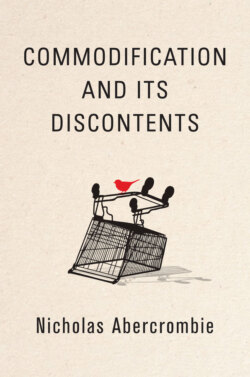Читать книгу Commodification and Its Discontents - Nicholas Abercrombie - Страница 9
Money and Markets
ОглавлениеIn this introductory chapter, I have been considering widespread fears for the well-being of society. These fears are often couched in terms of money and its use as a means of valuing human activities.
When, however, the Money Talk critique is pushed a little, it is not simply money that is relevant, but rather the social relations of money in a market that establish the money value of anything by giving a price. The fear of invasion is the fear of markets. As many have argued, price set in a market is not the same as economic value let alone other non-economic value (MacKenzie and Millo, 2003; Beckert, 2009; Stark, 2009; Fourcade, 2011; Beckert and Aspers, 2011). However, what Money Talk opposes is a way of thinking represented by participation in markets so that a money price, however it is set, becomes a guide to value. It is not how the price is set that is at issue, but that it is set, even if, as in the techniques of cost–benefit analysis, the actual market does not yet exist.
An exchange is any kind of transaction, which may be based in an ongoing social relationship, or even a fleeting interaction, between two or more people, which produces benefits – and costs – for all participants. Almost anything can be exchanged to mutual benefit in this way, not just objects but also services and sentiments such as love or affection. As Simmel notes, exchange is the basis of social life and the economy is a special case of ‘the general form of exchange’, that is, ‘a surrender of something in order to gain something’ (Simmel, 2004: 91). Conventionally, sociologists recognize three main forms of exchange: gift, barter and market. A critical distinction between these three is the use of money to facilitate the exchange. As Patrik Aspers (2011: 4) notes, a market is ‘a social structure for the exchange of rights in which offers are evaluated and priced’. That evaluation and pricing is effected by using money.
Markets understood in this way have a very long history, one that parallels that of Money Talk. Somewhat counter-intuitively, trade between societies, often a long-distance activity, was a comparatively early arrival. In the first millennium BCE, Minoan, Phoenician and Greek traders were active even if such activity was often difficult to separate from plunder or tribute or the exchange of gifts. Market places were a common feature of the ancient Greek and Roman worlds. It is, however, not entirely clear what the very early history of markets of this kind tells us about the development of market society more generally. Fernand Braudel (1981, 1982, 1984) argues that an economy based on markets only really became established in the twelfth century (see also Polanyi, 2001, who argued that price-making markets did not appear until the first millennium). Although market prices have always fluctuated, in that period they started to fluctuate in unison across and between countries, a development suggestive of systemic connection. Thereafter, market relationships gradually spread, producing ‘a generalised market society’ by the fifteenth century. For Braudel, capitalism is a layer of economic activity that develops above markets and has its roots in the thirteenth century, developing strongly in the fifteenth and becoming generalized by the eighteenth. Capitalism is best understood as the making of profit from transactions that is reinvested to produce further profit, which accumulates as capital over time. As Wallerstein has it, capitalism is about the self-expansion of capital for its own sake, and ‘it was this relentless and curiously self-regarding goal of the holder of capital, the accumulation of still more capital, and the relations this holder of capital had therefore to establish with other persons in order to achieve this goal, which we denominate as capitalist’ (Wallerstein, 1983: 14).
Capitalism provides the dynamism, the energy, for the expansion of markets, for commodification. And, indeed, it is the sense of violent and destructive energy – of being overrun by an irresistible force – that pervades much of Money Talk. That sense is famously captured by Karl Marx and Friedrich Engels in pamphleteering mode in The Communist Manifesto. The bourgeoisie, the agent of capitalism, ‘put an end to all feudal, patriarchal, idyllic relations’, ‘resolved personal worth into exchange value’ and has ‘stripped of its halo every occupation hitherto honoured and looked up to with reverent awe’.
Constant revolutionizing of production, uninterrupted disturbance of all social conditions, everlasting uncertainty and agitation distinguish the bourgeois epoch from all earlier ones. All fixed, fast-frozen relations, with their train of ancient and venerable prejudices and opinions, are swept away, all new-formed ones become antiquated before they can ossify. All that is solid melts into air, all that is holy is profaned. (Marx and Engels, 1968: 38)
And a century later, Marshall Berman writes similarly of the condition of people of the late twentieth century as being ‘moved at once by a will to change – to transform both themselves and their world – and by a terror of disorientation and disintegration, of life falling apart’. There is an atmosphere ‘of agitation and turbulence, psychic dizziness and drunkenness, expansion of experiential possibilities and destruction of moral boundaries and personal bonds, self-enlargement and self-derangement’ (Berman, 2010: 18).
This brief summary of the very large topic of money and markets is designed to spell out some of the assumptions in the argument of this book. Commodification is about the way in which markets give financial rather than moral value to objects transacted. A capitalist market society provides the energy for further rounds of commodification. Market society precedes the development of capitalism and it is possible to conceive of such societies without capitalist organizations, such as societies involving collective ownership.
